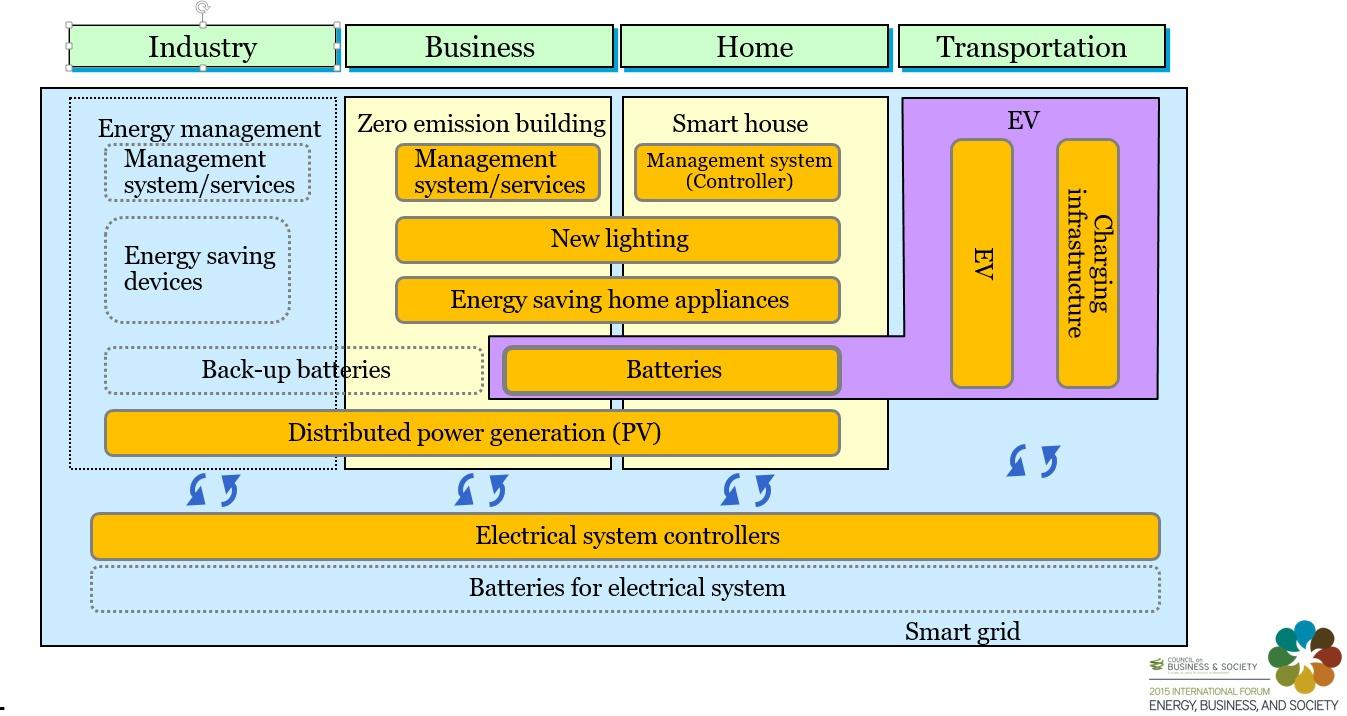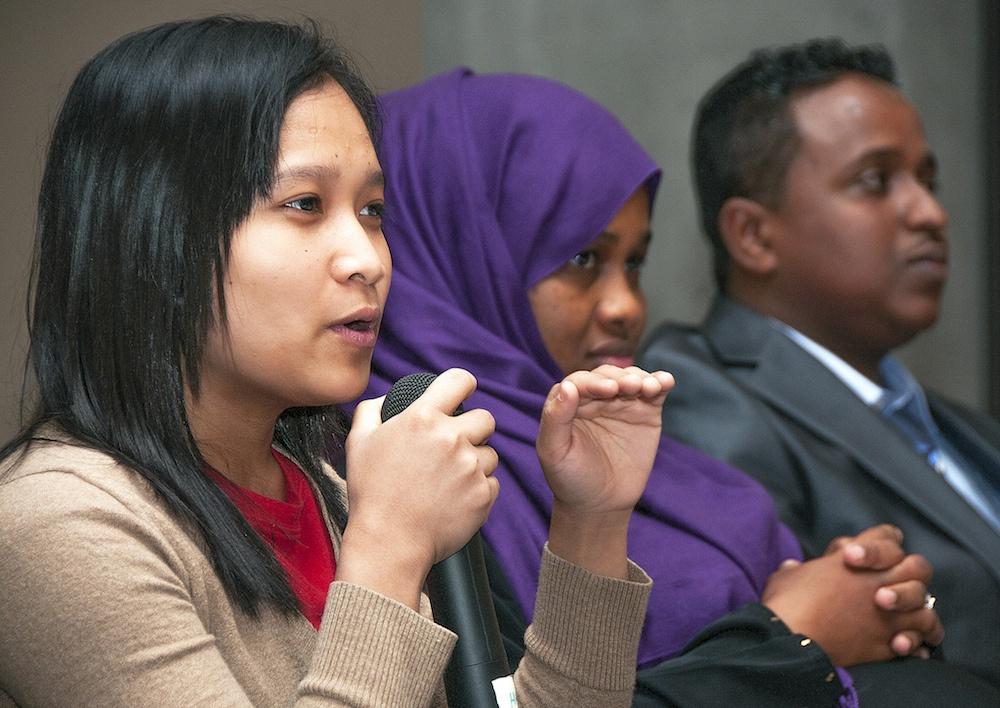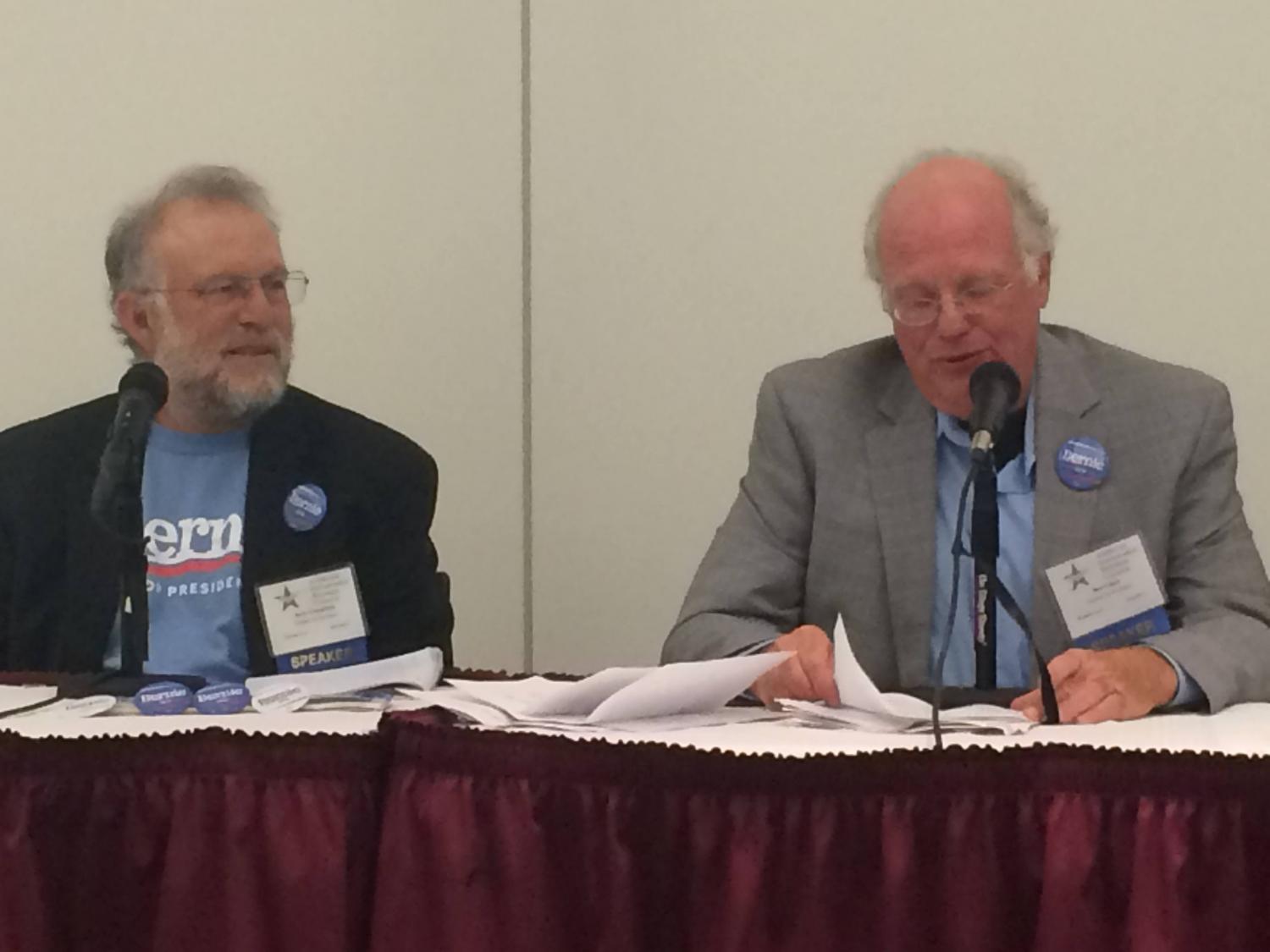Japan Smart Cities Project Wraps Up With Impressive Results


Back in 2013 we did a story on a Smart City pilot that was underway in Japan. The experimental program, which began in 2010, took place in four cities: Yokohama, Toyota City, Keihanna Science City (Kyoto Prefecture), and the city of Kitakyushu. Among the concepts that were incorporated in the project were the integration of electric vehicles with renewable power sources on and off the grid and sophisticated home and building energy management systems.
The pilot was completed in March of this year and Professor Takashi Iwamoto of Keio University, who was instrumental in its development, came to Boston last week to discuss the effort at the Council on Business & Society Forum. The project was undertaken with the support of Japan’s Ministry of Economy, Trade and Industry (METI) in the hopes that it would lead to exportable technology. The scope of the project included elements for energy-efficient business and industry, energy-efficient homes, support for green consumer behavior, and a low-carbon transportation system.
A number of metrics were developed which will hopefully lead the way to international standardization at the levels of infrastructure, facilities, and services. These are being coordinated through an International Standards Organization (ISO) task force on smart cities. The outlook for smart cities is for an $8 trillion market by 2030, with the primary sectors being energy, public service, home network, and healthcare.
Among the results, in Yokohama City, Demand Reduction (DR) efforts found varying degrees of success, depending on how the DR was implemented. Reductions in electricity demand ranged from 4.2-7.2 percent with the highest reductions seen among those who were given incentives. The large amount of data collected by the Home Energy Management System (HEMS) provides the opportunity to learn a family’s lifestyle and balance the desire to conserve power with comfort. One of the panelists in a public debriefing session, Professor Takanori Ida of Kyoto University, said that "The entry point here was our aim to realize smart lives and smart cities through energy, but I feel that health care will be a focus at the exit of the project."
The Toyota City portion of the project, entitled, “Smart Mobility & Energy Life in Toyota City” deomstrated that energy savings could be achieved with a DC control system that utilized as much of the rooftop PV power as possible, combining battery storage with DR-type strategies that utilized equipment at optimal times. Results were sufficiently encouraging, that according to DENSO, rooftop PV should achieve grid parity before 2020. The software, which is called Naviehe, collects data on electricity usage as well as that of water and gas. Its use of automation reduces energy waste. The company plans to market the software abroad.
In Keihanna, some 700 households participated in the study. These were divided into four groups, each receiving a different level of information regarding their electricity consumption. Included were basic consumption, time-of-use pricing (TOU), critical-peak-pricing (CPP), and energy consultation. These were combined with demand reduction opportunities which included financial incentives. Energy savings for the TOU group were 7 percent in summer and 14 percent in winter. The CPP group, on the other hand, saw 7 percent in winter and 33 percent in summer. Analysis shows that much of the variation correlated with times when people were at home and were able to take advantage of DR opportunities.
In Kitakyushu, building energy managements systems (BEMS) that included solar hot water were tested. Results there showed that when automated response systems were supplemented by human interaction (building occupants were notified by email when rates were about to go up,) energy savings of up to 45.9 percent were achieved.
Now that the pilot program has completed, the group of companies involved are now looking to export their gained knowledge and technology, which was Iwamoto’s primary message at the Boston conference. Some of the 40 companies involved include: Toyota Motors, DENSO, Dream Incubator (consultant), Hitachi, Sharp, Mitsubishi, Toshiba, Yamaha, Sumitomo Electric, Hewlett-Packard (Japan) and others.
Image courtesy of Takashi Iwamoto
Be Part of a Movement: The Biomimicry Track at SXSW Eco


By Janine Benyus
Biomimicry has grown tremendously since I first wrote about it in 1997. In fact, it has graduated from a meme to a movement.
We now find ourselves asking: What if biomimicry influenced as many areas of human endeavor as possible, from urban renaissance, to food security, to CO2 drawdown?
Biomimicry is best known for the design of smarter products and cleaner manufacturing. Today, biomimics also are delving into the patterns of entire ecosystems to bring wisdom to complex worlds such as city planning, finance, and social innovation.
At SXSW Eco, dozens of speakers from our growing edge will paint a portrait of where we are now—like one of those amazing photo mosaics assembled from smaller images. Here’s what you can expect to see and hear in each session:
Business as Nature: New Models and Innovation
Here we’ll see how the discipline of biomimicry is evolving to help business and social innovators learn from complex ecosystem relationships. We’re looking to communities of organisms to understand how to self-organize, how to build resiliency, and how to communicate and cooperate on grand challenges.
I’m especially excited to see biomimicry applied to something as pivotal as investing. Katherine Collins is looking to nature to understand how we can invest in tangible enterprises that nourish community and create true wealth, rather than just multiplying margins a la “Flash Boys.”
At the foundation of all these new models is a paradigm shift. It’s the realization that as part of natural systems ourselves, we needn’t be in head-to-head competition with one another. Rather, we can create networks of symbiotic support.
From Metaphor to Metrics: Net Positive Businesses
This session will examine what it looks like when businesses literally try to function like an ecosystem.
Companies like Kohler and Interface have demonstrated that progressive corporations can be sources of environmental and social solutions, not just problems. For many years the conversation has been about reducing the negative impacts of business—reaching net zero. Now the conversation is shifting to net positivity. How does a company do business so that it heals local economies and ecologies?
Biomimicry can supply companies with the metrics and models for cleaning air and water, supporting biodiversity, building soil, and beginning to reverse climate change. Here, we’ll see that ambitious innovation is no longer about single inventions, it’s about systems-level thinking.
Beyond Biophilic Cities: Solutions Rooted in Place
As with business, we’re also beginning to ask more of another complex system—the city.
When we talk of biomimetic cities, people tend to think: greener, with more trees. That’s part of the equation, but we’re actually setting the bar much higher. We’re asking buildings, and cities at large, to provide the same ecosystem benefits that forests in those locations would. It means designing solutions that produce much cleaner air, much cleaner water, much more fertility. This is a first for city planning.
Behind the Innovation: The Biomimicry Success Stories You Haven't Heard
Building a circular economy, investing in companies that do good—those are all intentions that have to be supported by innovation. What makes biomimicry so compelling is that it provides a coherent vision of a world that works and outlines a granular, practical innovation path.
At Biomimicry 3.8, we haven’t spoken publicly about most of the client work we’ve done over the years. I think people will really enjoy hearing these case studies and learning about how our biomimics assist in solving complex, functional challenges. We’ve created a methodology for distilling the design principles beneath so much amazing biodiversity. We’re just as proud of our code of ethics, which aims to make every cool invention an earth-friendly one. I know my co-founder Dayna Baumeister is going to make this an eye-opener.
Open Innovation Challenges, Inspired by Nature
In six years of Global Design Challenges at the Biomimicry Institute, we’ve learned a lot about what 21st Century inventors look like.
To help solve society’s major problems, we need to look beyond the lone inventor model. Today’s successful inventors don’t have to be a part of a university or a company, either. You just need an earth-savvy idea, the ability to articulate it, and be able to envision it as a business.
We’ve had people from 70 different countries participate in our Global Design Challenge. In fact, the last four winners were from emerging economies: Iran, Egypt, South Africa and Mexico. Here’s another statistic many find surprising: Challenge participants are split 50-50, male and female. I think this diversity is the root of the ingenuity you’ll see in this year’s group of finalists.
Tools to Bridge Science, Design & Discovery
The big goal is to empower people to do biomimicry, to practice the discipline and bring it into the world.
As with any discipline, certain tools are necessary to make it real. Our network is now creating those tools, and several will be discussed in this session. The new version of AskNature.org makes biological intelligence globally accessible and actionable. Zygote Quarterly, a beautiful publication at the nexus of design and biology, is a crucial record and voice of the biomimicry movement. And Terrapin Bright Green is successfully matching biomimetic innovators with the financing they need to enter the market.
Nature is the Epicenter of Innovation
Moving biomimetic solutions into the marketplace on a disruptive scale is the topic of this session.
Mark Dorfman is Biomimicry 3.8’s in-house chemist. Despite the bad rap chemistry often gets, nature is proof that toxins are not necessary to create amazing products. But there’s a big challenge to break away from entrenched product development and manufacturing processes.
Our aim, whether at Biomimicry 3.8 or the Institute, is to work with partners to catalyze nature-inspired innovation. Panelists will discuss how that could be done on a scale large enough to tackle a global issue like climate change.
The Great Reunion: Seeds of a Biomimetic Future
Lastly, in my presentation, I’m going to imagine what the world would look like if we truly succeeded at scaling biomimicry.
That brings us back to the questions I asked above.
What if we embedded biological intelligence in as many human endeavors as possible? How would that move us toward a safe and just world, and how do we unify as a network to get there?
That’s the call to action.
Janine Benyus is a biologist, innovation consultant, and author of six books. Over the past 17 years, she has personally introduced millions to the meme of biomimicry through two TED talks, hundreds of conference keynotes, and a dozen documentaries such as 11th Hour, Harmony, and The Nature of Things with David Suzuki. She is the co-founder of Biomimicry 3.8 and the Biomimicry Institute.
Image courtesy of Biomimicry, used with permission
New sustainability reporting awards launch in Asia


Entries are now open for the inaugural Asia Sustainability Reporting Awards, the first such awards for the region.
An independent panel of judges including Alex Mavro (coo, Centre for Sustainable Management, Chulalongkorn University, Bangkok), Dr Annie Koh (professor of finance, Singapore Management University), Christopher Ang (executive director, Global Compact Network Singapore) and Elaine Cohen (ceo, Beyond Business) will judge the entries and decide the winners.
The Awards are being offered in 14 categories including Asia’s Best Sustainability Report, Asia’s Best Integrated Report, Asia’s Best Sustainability Report (SME), Asia’s Best First Time Sustainability Report and other specialized categories with focus on carbon disclosure, stakeholders, supply chain and community.
The Awards, an multi-stakeholder initiative are being organised by CSRWorks, the Singapore sustainability advisory firm. The company believes that the awards will create a much needed platform for sharing best practices, benchmarking and peer learning by bringing together the leaders in sustainability reporting.
Entries are welcome from all sizes of organisations from all sectors.The final deadline for entries is 23 November 2015. The winners will be announced in mid-January 2016 at an awards function in Singapore.
For further details click here.
Investors warned over risk exposure in backing extractives companies


Almost a third of all natural World Heritage Sites has the threat of oil, gas and mining exploration hanging over it, according to a new report.
The threat rises to 61% in Africa. Natural World Heritage Sites are places of outstanding natural value, such as the Grand Canyon, the Great Barrier Reef, and the Selous Game Reserve in Tanzania.
The new assessment - in a report called Safeguarding Outstanding Natural Value, produced by WWF, Aviva Investors and Investec Asset Management - puts the risk at a higher level than previously thought. The report also brings to light the risk to investors of involvement with extractives companies working, or intending to work, in or near these special places.
Covering less than 1% of the planet and containing outstanding natural value such as iconic landscapes and species, natural World Heritage Sites are in increasing danger of exploitation and irreparable damage, which in turn damages the communities who depend on these amazing places for their livelihoods. Furthermore, natural World Heritage Sites are home to some of the rarest animals on Earth.
The threat level relates to active operations by extractive companies, or intrusion that may come as a result of concessions for exploration of minerals or oil and gas overlapping these sites.
Investors are being warned in the report of their risk exposure if they back the companies involved, both in terms of financial risk and threats to their reputation.
To access the full report click here.
Picture credit: © Slav8 | Dreamstime.com
Five Strategies to Promote Diversity in Tech


Diversity in the tech community is a hot topic these days as several industry giants like Facebook, Twitter, and Google try to shed the unfavorable public perception of being a boys club. It’s no secret that Silicon Valley is made up predominately of straight, white, men. However, there are several tech companies who are aware of the lack of diversity and have made a commitment to undergo significant changes.
“We have a goal to reach every person on the planet.” Twitter stated in an article published on their blog last year. “We believe that goal is more attainable with a team that understands and represents different cultures and backgrounds.”
Tim Cook, the CEO of Apple Inc. echoed this sentiment stating, “Diversity is critical to innovation and it is essential to Apple’s future. We aspire to do more than just make our company as diverse as the talent available to hire. We must address the broad underlying challenges, offer new opportunities, and create a future generation of employees as diverse as the world around us.”
In an effort to fuel this movement towards a more diverse tech industry, one startup is partnering with innovative companies like Pinterest and Airbnb to help build a stronger, more diverse organizations. Paradigm works with companies to cultivate and leverage the power of diversity by using an innovative, iterative, and metrics-driven approach. The company, spearheaded by CEO Joelle Emerson, uses both quantitative and qualitative analysis to identify potential patterns of biases and disparities.
Emerson has identified five strategies that she believes tech companies should engage in to build more diverse and inclusive organizations.
1. Founders and leaders: get involved
Diversity initiatives are far more successful when a leader within the organization plays an active role. An increasing number of startups have individuals or teams thinking about diversity, which is a step in the right direction. However, these roles are often filled by recruiters with a passion for diversity who often lack the necessary support and resources to make meaningful changes company-wide.
For example, when Etsy decided to boost its gender diversity, former CTO Kellan Ellitot-McCrea was involved in restructuring the company’s recruiting and hiring approach. After a year, Etsy had grown the number of female engineers by almost 500 percent.
Emerson recommends that at least one C-suite level executive, and preferably a founder in new companies, should be directly involved in these efforts, developing company goals around diversity, supporting and rewarding employees who dedicate their time to building a diverse organization and ensuring accountability.
2. Collect better data
The release of diversity data from a number of tech companies in 2014 helped to quantify the industry’s problem and sparked a broader conversation about solving it. However, despite this move towards transparency, there is often a reluctance to collect more meaningful and granular data related to diversity. Without good data, it’s nearly impossible to know which processes in an organization are most inhibiting diversity and where strategies should be targeted to produce the best outcomes.
In general companies should be looking at the following areas: how candidates are attracted and recruited; how work is assigned; how performance is evaluated; how much employees are paid; how employees advance in the company and when they leave; and how happy employees are. Embedding these data-collection measures early will make it far easier for companies to identify and address barriers to building a diverse organization.
3. Expand your network
Emerson explains that tech companies often attribute their lack of diversity solely to the lack of diversity in computer science and computer engineering programs where most hiring comes from. But this pipeline problem doesn’t account for the significant gap between the percentage of African-American and Hispanic graduates in computer science and computer engineering (11 percent from top research universities alone) and the representation of those groups in technical roles in Silicon Valley (around 5 percent). Nor does it explain the diversity gap in non-technical roles.
Until the pipeline is more diverse, tech companies should prioritize finding and hiring diverse employees from sources outside their traditional networks. The process most companies use to find candidates — relying on informal social networks and referrals from current employees — is a great approach for finding more employees like the ones you already have. For a company that’s not yet diverse, this can perpetuate the problem. Companies committed to diversity need to make a conscious effort to build more diverse networks and find these candidates.
4. Think deliberately about your hiring process
There is a common perception among startups that the hiring process is designed to attract and select the best person for a given role without regard for gender, race, or ethnicity, and that efforts to hire more diverse candidates require changing standards. This is based on the flawed assumption that the hiring process is purely based on merit. However, In the overwhelming majority of companies, even despite best intentions, it’s not.
Social and psychological factors like unconscious bias and stereotypes can hinder success in the recruiting process for diverse candidates who apply. Unconscious bias can lead interviewers to unintentionally apply different standards to diverse and non-diverse candidates. Awareness of these issues, and a focus on strategies that minimize their impact, will lead to more effective recruiting of diverse candidates and better hiring decisions overall.
5. Create a company culture that supports diverse employees
The high attrition rate among women in tech and the lack of diversity in leadership roles in tech companies indicate that there are obstacles to success for women and people of color in the industry. Building a diverse organization requires a focus not only on recruiting diverse candidates, but on creating a culture that welcomes and cultivates diverse employees.
Creating such a culture should include establishing explicit structures that support diverse employees, like better paid leave for new parents — a benefit that significantly reduced women’s attrition at Google. Instead of waiting to be in the position that larger tech companies are in now — investing heavily in diversity to achieve only incremental change — startups should begin focusing on diversity today.
Image Credit: Flickr/Oregon Department of Transportation
XPrize to Pay $20M for Successful Carbon Capture + Conversion


We've tried getting rid of carbon emissions in multiple ways: by reducing them through regulation and incentives, by establishing cap and trade programs that balance the impact and reward reduction, and by incentivizing corporations to reduce them through innovation.
That last concept highlights better than most, just how hard it is to replace carbon emitting technology. Some would argue that the Volkswagen scandal is not just an indicator of values gone awry, but the considerable challenge of creating technology that meets our ecological standards. Judging from recent studies, it's harder than we think to replace our old way of generating power.
So the backers of the renowned XPrize has come up with another option: carbon conversion.
As is so often the case, this year's XPrize is dedicated to answering the seeming unanswerable -- figuring out how to capture those carbon emissions and convert them into handy uses -- really handy uses. Potential contenders will be happy to know that some of the work has already been done for them: scientists have already dabbled in converting carbon to synthetic diamonds.
But the XPrize backers, which include the Canadian Oil Sands Innovation Alliance and NRG, are looking for more. The contestants, when presenting their ideas, must be able to "prove they can be deployed at power plants and other industrial facilities.
"Ultimately, the impact of the prize will go far beyond the critical demonstration of innovative technologies," says the website, by incentivizing new markets and new investments. Reducing the current exorbitant cost of carbon dioxide removal (CDR) technology is also essential.
And the prize for doing so is nothing to sneeze at. A total of $20 million has been pledged by the backers, to be divided according to several benchmarks of competition: the proposal and testing in a lab setting, and the formal demonstration in a power plant.
Two tracks of competition have been developed: one for coal power plants and one for natural gas. For each track, a pool of $2.5 million will be divided among the contestants that pass the lab stage, and $7.5 will be awarded the winner who can demonstrate the most practical application for carbon conversion in a power plant. Teams will be scored on how much C02 their technologies convert as well as the net value of their products.
The Carbon XPrize formally launched on Sept. 20, and is expected to garner a fair amount of attention across the globe, which is of course just what the XPrize team is looking for. The more entrants, the better the chance of finding a more affordable, useful technology for CDR.
"As with any Prize it’s open to any innovator,” said Peter Bunje, XPrize's principal and senior scientist for energy and environment. “But you have to prove you can do something impressive.”
Image credit: Carbon Visuals, Flickr
Volkswagen, Audi Return 2009 & 2010 Green Car of the Year Awards


The dominoes continue to fall as the impact of the Volkswagen emissions scandal deepens. There are now allegations that high-level managers in the company’s research and development department were warned about possible illegal practices, a revelation that came out a day after the company suspended several R&D chiefs until more details about the “defeat device” fiasco become more lucid. Volkswagen has also said it will come up with a plan to retrofit cars affected by this software installation, a cost that could reach in the billions of dollars as 5 million of those affected cars alone are in the U.S. Failing at explanations that are falling short of satisfying the media and consumers alike, Volkswagen has hired a new global head of communications.
And there will still need to be a lot of explaining to do as yesterday Volkswagen and Audi agreed to return “Green Car of the Year” awards bestowed upon their 2009 and 2010 “clean diesel” models. San Luis Obispo-based Green Car Journal rescinded its prizes for the 2009 VW Jetta TDI and 2010 Audi A3 TDI in the wake of Volkswagen's admission that the company had deceived government regulators about the emissions levels of the 2010 Audi winner.
“We only want to win fair and square,” said Audi of America President Scott Keogh in a written statement. Keogh added that the Volkswagen group of brands had won hundreds of awards over the years throughout the company’s history, and says it hopes to win the award “properly” in future years.
Critics of the company, however, are not stopping with any green or environmental awards. They are increasingly demanding that Volkswagen return additional awards the company has recently won, including the prestigious North American Car of the Year and Motor Trend Car of the Year. Volkswagen had swept both of those awards earlier this year with the 2015 Volkswagen Golf and Golf GTI. Motor Trend in particular called out the Golf models for its improved fuel efficiency and fuel economy gains.
But now the knives are out.
“In light of the fact that VW has been cheating the emissions on their vehicles for the past 10 years with their TDI's, Motor Trend should rescind the award for Car of the Year,” said one anonymous reader, with others on the thread agreeing with that sentiment.
Whether or not these calls will crescendo and force Volkswagen to humiliate itself even further by returning even more awards remains to be seen. What is definite, however, is that Volkswagen has larger problems than returning a few shiny plaques and trophies from the lobbies of its corporate offices. The U.S. federal government had reportedly paid $51 million in subsidies for purchases of the Volkswagen and Audi models in question. Across the Atlantic, Spain’s government has demanded Volkswagen’s subsidiary operating in that country return subsidies that had been paid to develop more fuel efficient automobiles.
No matter how sour the public goes on Volkswagen, it will be possible for the company to recover and regain trust. But that process could take years, and in the meantime, the financial penalties the company is confronting will become an even larger hurdle for the world’s largest automaker.
Image credit: OSX
Rationality is Ruining Us: Final Thoughts on Climate Week


The rationality of business leaders is leading us to complete disaster.
Voicing concern for the continued lack of action on climate change, World Bank President Dr. Jim Yong Kim joined many others at the closing ceremony of Climate Week NYC 2015 (CWNYC) in imploring the community to wake up and smell the air (no pun intended).
Referring to the ever maddening chase of the business case across corporate America, Dr. Kim emphasized that we now have enough facts and figures to address a global crisis unraveling in real time in places like California (see: drought and water shortage), island nations (land erosion) and across our depleting oceans and forests.
“My son will live through a 2, 3 or maybe even 4 degree Celsius warming. We cannot keep apologizing to our children for our lack of action. We must change course now,” he added, vocally seconded in frustration and urgency by many others who took the stage after him, including Former President of Mexico Felipe Calderon.
After more than ten days of events spread across New York City and covering a multitude of topics – from climate data and social justice to poverty, Rule of Law and women empowerment – CWNYC ended with several notable announcements this week, including commitments from Walmart, J&J, P&G and Nike to strive for sourcing 100 percent of their energy needs from renewable sources, six national banks coming together to ask for a climate treaty and divestment numbers reaching $2.6 trillion.
Mayors, Governors and Ministers Urge Urgent Attention
The week also saw the likes of NYC’s celebrated former mayor Michael Bloomberg and India’s Union Minister of Environment Prakash Javadekar taking the podium to ask policymakers globally to agree on a binding climate agreement at the upcoming Conference of the Parties (COP21) in Paris this December. While Mayor Bloomberg emphasized “you get what you pay for” and that “businesses invest where people live,” citing that New York City continued to be a mecca for business investment because of its early attention to the impact of climate change, the Indian Minister asked policymakers to frame climate change more broadly as a need to shift consumption patterns and lifestyles.
Referring to Pope Francis’ articulation of the “throwaway culture, the minister added, “India is a big country but it is also a poor country…this is about lifestyles and financing a global shift to cleaner sources of energy.”
Poverty is “the biggest pollutant” he said. “Human intentions have led us here and human intellect will help us lead the way out.”
For Vermont Governor Peter Shumlin, climate change is no longer up for debate. Emphasizing that his state’s residents were already living with the impact of climate change and were fully engaged on adaptation, he said, “We don’t live in the land of denial…a whole generation of Vermonters are learning about climate change the hard way.”
Open for Business: Corporations Show Early Results from Climate Adaptation Efforts
Not too far behind was the corporate contingent including leaders from Ikea, Kellogg’s, Walmart, Nike, BT, DSM, Philips, Siemens and many others as well as the State of New York Comptroller’s Officer, who participated in a plethora of rapidfire discussions, many ably and enthusiastically moderated by UNFCCC Executive Secretary Christiana Figueres, on how they were accounting for climate change risks through various tactics and strategies. Here’s a sample:
- Product innovation: Siemen’s is rolling out hundreds of windmills, estimated to power 7,000 – 8,000 homes each, Philips and Ikea are leading drive toward LED lighting
- Advocacy: BT working across sectors on rolling out infrastructure to support the future of clean technology, automation and access for all, Mars joining hands with many other companies through investor advocacy group Ceres asking policymakers to agree on a climate treaty at COP21
- Value chain mapping: According to Nike’s Chief Sustainability Officer Hannah Jones, the amount of polyester used in one year uses as much fossil fuels as it takes to operate 185 coal plants. Materials matter, she emphasized and therefore, Nike is evaluating its entire ingredient and value chain to understand all points of impact.
- Circular thinking: Ikea looking ahead at leasing its products, extending their life and helping customers resell, recycle and reuse.
- Scenario planning: NYS Comptroller’s office increasingly looking at “where we put our money. If companies don’t change their practices, we will move the money.”
None of His Business: Finding the Way Forward in Pope Francis’ Words
In an equally dramatic setting ahead of Pope Francis’ visit to the U.S. – New York City’s Jesuit University, Fordham – Andrew Winston, author of The Big Pivot, Jo Confino, Executive Editor at The Huffington Post, L. Hunter Lovins, president of the Natural Capitalism Solutions and Michael Pirson, Associate Professor for Management Systems at Fordham took the stage to contextualize why a religious leader was cutting through religious and political clutter to issue an urgent call to action.
Before a packed auditorium of students, professors and others, the three distilled the 80 page Papal encyclical for what this meant for business, for consumers, students and perhaps more overwhelmingly, for humanity. The conversation was variously electric, sarcastic, alarming and deeply touching.
Winston cracked open the discussion by urging the audience to pay attention to what the Pope is saying. “If the Pope is signaling that the end might be nigh, we better sit up and listen. We have serious equity problems and we better start connecting it with environmental challenges quickly.”
Bringing a politically charged topic to life, Lovins alluded to the millions of refugees making their way west from Syria in the hopes of a happier life. “Are we prepared for what that means for our cities, our local economies?” she asked. “I’ve always said climate change is not a moral issue; it is a business opportunity. But the Pope is starting to make me change my mind… This [climate change, poverty, economics] is not a religious issue. This is a global issue for humanity to confront and address as humans.”
Confino, who recently left The Guardian to lead Huffington Post’s foray into purpose and impact reporting, chose to take a more philosophical point of view advocating that “we need to re-convince ourselves that we need each other; that we don’t have control over everything whether we like it or not.”
On the other hand, Pirson implored education institutions to sit up and take note of what this meant for them. “Every institution has to ask themselves why they exist and how they are helping the world move forward sustainably. This is a crisis and we need all hands on deck. Everywhere. If we’re not demanding that, we’re wasting our time,” he said.
So where to from here?
When do we shift from call to actions to simply action? While many more companies are stepping up their efforts – General Mills and Kellogg’s serving as great examples as they begin their path toward net zero – on the various threads of climate change, many, many more remain in the shadows waiting and watching.
Regardless of what gets agreed to in December, climate change is already changing our summers and winters (check out WXshift to see for yourself). Changing weather patterns are already impacting farmers’ harvesting timelines and forcing millions to relocate for better proximity to clean water and air. And as this impact spreads beyond the immediate areas under threat, our notions of ordinary and luxury stand to be tested.
We’re going to have to respond. We’re going to have to adapt. Our bottom lines will change.
And we’re going to have to continue to push the leaders and pull the stragglers along. After all, if the future of our children is not worth it, what is?
17 Goals to Rule Them All: How the SDGs Can Benefit Organizations


By Nadia Kähkönen
Inked last week, the new sustainable development goals (SDGs) might just signal the start of something revolutionary.
Committed to by world leaders at the UN Summit in New York, the 17 proposed goals and 169 targets aim to be a charter for people and the planet in the twenty-first century. Debated by civil society and UN member states for more than two years, the goals will stimulate action over the next 15 years in areas of critical importance to building a more equitable and sustainable world for all. The SDGs will ultimately replace the millennium development goals (MDGs), which expire at the end of this year.
The aim of the new SDGs is ambitious: End extreme poverty; fight inequality and injustice; fix climate change. In all countries, for all people. The goals come not a moment too soon: Climate change is rapidly becoming the greatest threat to poverty eradication and negatively affecting sustainable development efforts. If action is not taken to cut emissions and support communities to adapt to the changes, its impacts will only increase.
The SDGs will further enhance the importance of so-called co-benefits accrued from tackling climate change and streamline impact measurement across all development domains. Co-benefits are the added benefits when acting to control climate change, beyond the direct benefits of a more stable climate. They include items such as enhanced livelihood opportunities, women empowerment, health and education.
For example, the health benefits of cleaner air may actually exceed the costs of climate action and prove even greater savings than simply the advantages of avoided air pollution. While quantifying the advantages of addressing climate change can be tricky, the benefits of cleaning up the air in a local town are much more immediate. For most developing countries, and to a large extent donor communities as well as the private sector, the potential of programs, projects and/or policies to deliver tangible co-benefits forms the basis of investment decision making.
Ultimately, the SDGs will affect organizations and institutions of all shapes and sizes, from the European Union to municipalities and corporations, and engagement from a wide scale of actors will be crucial in shaping the future agenda. The playing field and the adoption of the SDGs marks a new era for both the public and private sector to deepen and broaden their sustainability efforts. In comparison to their predecessors, the SDGs are much broader and more difficult to measure. However, they represent a bold move towards a more ambitious, yet more realistic and inclusive development agenda - a golden opportunity for governments, private enterprise and civil society to work together in tackling the biggest challenges on the planet.
The SDGs convey, for instance, one of the strongest expressions of the critical role of cities in the world's future by aiming to "make cities and human settlements inclusive, safe, resilient and sustainable." For example, cities are responsible for 70 percent of greenhouse gas emissions at the global level. This goal also enshrines links to adaptation to climate change and community resilience. Ensuring that all the targets for adaptation and capacity building at a city level translate into a success, strategic plans and frameworks involving policymakers at all levels will be a must-have for sustainable urban development.
Where the agenda of the predecessors, the Millennium Development Goals, was centered around actions by governments, the SDGs seek to involve a diverse range of actors – including, crucially, a more prominent role for the private sector.
Goal 16 advocates the promotion of "peaceful and inclusive societies." This will essentially have an effect on the decisions taken with regards to instruments for investment, i.e., what tools must be made available for businesses to better allow for support of domestic resources. The SDGs will open the floor to provide more instruments supporting longer-term investments coming from the corporate side, such as much needed credit guarantees. Put simply, the sustainable development goals will guide the way in which governments spend their money - if a business can tackle any of these goals, there will be money to be made.
Contributing to the SDG agenda can enhance one's own goals and aspirations as an organization. For the private sector, the SDGs can provide a more focused direction on how to boost the quality of sustainability goals, position them as commitments, and better communicate them in a credible and meaningful manner. Not to mention improving standards and mitigating risks along the supply chain. By striving to better integrate sustainability in its operation, Ikea has sparked transformational change in the market for commodities, namely cotton, and a more efficient use of resources within its own supply chain. Partnering with the Better Cotton Initiative, Ikea not only improved the livelihoods of 43,000 farmers in South Asia, but also significantly reduced the amounts of costly artificial fertilizers it used. This is inspiring news for anyone operating in the textile industry where pesticides and chemicals can account for up to 60 percent of farming costs, and where forecasts see production costs increasing as conventional cotton farming becomes more water and chemical intensive.
In the public realm, the SDGs can create a fine opportunity for goal-oriented policies that will improve the quality of democratic practices around the world. The SDGs are also likely to spur growth in the Results-based Financing model, in which a "payer" (a government, international donor, or a foundation for example) conditions its payment to a service provider (a private company or a NGO for example) on desired outcomes. Results-based financing bears great potential to improve the efficiency and quality of public services (and development aid in general) through a greater private sector involvement and other benefits such as reduced corruption. Carbon markets are currently the biggest and most prominent form of Results-Based Financing within the realm of sustainable development. The lessons learned in carbon markets over the last 15 years, will play an important role in helping to expand this experience to other SDGs.
The actions taken during the New York Climate Week are just part of the bigger picture. By acknowledging and reacting to the implications of the SDGs, organizations and institutions can ensure thriving environments in which to operate in. Ultimately, they can play a leading role in delivering a healthier, cleaner and an increasingly more prosperous future for all.
***
Nadia Kähkönen is South Pole Group's Communications Manager. She is a strategic, multidisciplinary communicator with an eye for visual content and a passion for storytelling. She has solid experience of working in dynamic, international communications environments in the fields of climate action, CSR and sustainable development with the European Commission, CSR Europe and UNESCO.
Ben + Jerry Speak for Bernie at American Sustainable Business Council


The American Sustainable Business Council (ASBC) opened with a lively debate between representatives from Sanders for President and Clinton for President. The ASBC invited the leading republican campaigns to attend as well, but they all declined.
"Our system isn't broken, it's rigged," Ben Cohen explained as he took the stage with his longtime partner-in-crime Jerry Greenfield. In the allotted 15 minutes, the duo ran through a litany of inspiring platforms from the Sanders for President campaign, all designed to make our country more just and equitable: universal healthcare, college subsidies, capital infrastructure investments to reduce youth unemployment. To fund these feel-good policies, the Sanders campaign advocates ending the cap on social security payments (currently income over $130K is not subject to social security taxes), eliminating offshore tax havens, and finally, "billion dollar corporations that don’t pay taxes should be illegal."
Jerry closed out their 15 minute platform by saying,
"Bernie has a comprehensive + specific platform. People respond because they know that he’s right. Bernie can get elected, does get elected, gets re-elected. Great leader. Great programs. Guy is honest, tells the truth. Voters are yearning for people who tell the truth, who aren’t 'politics as usual.'.... It’s going to come down to big money vs. people power. We’ve seen people power win over and over IF people show up.
At the start of the session, ASBC circulated a survey of key policy issues for its membership: carbon tax, increase high road business practice and policies; create more opportunity for small and mid-size American businesses; and modify tax code to level the playing field for small and mid-sized businesses and asked the audience to rate each camp on ability to meet the group's policy goals. In short, ASBC's policy priorities are the practical kind that benefit the business community but may not be so inspiring. And it may be too early in the political cycle for these sorts of policy proposals. But for better or worse the Bernie camp didn't expound on the details of the policy plan.
Since Greenfield and Cohen are members of the ASBC and clearly the home team, Elgie Holstein for Clinton knew he had his work cut out for him when he took to the stage.
I figured they'd bring ice cream, so I hunted through my cupboards. Graham crackers wouldn't do, maybe some fancy salt water taffy from the shore. I didn't bring it because I figured they [Ben + Jerry's] probably already have that flavor, and also I really didn't want to give up my taffy. Put me down as insufficiently committed to the democratic process that I didn’t want to give up my saltwater taffy," He joked.
He went on to outline Clinton's political commitment to incentivizing renewable energy by expanding tax credits. "Its embarrassing to see how congress treats the renewable tax credit: It creates new jobs, clean jobs. And Congress waits until the end of the year to extend it year after year." Clinton, he promised, would extend the hand of government to support and incentivize clean energy, even if it requires bypassing congress and issuing an executive order. He didn't outline any other platforms, aligned with the ASBC's goals or otherwise.
In the many months to go until the Democratic primaries, the fight for the nomination is sure to continue to focus on consumer issues -- those that inspire voters to get to the polls. While businesses are made up of individual voters, it's cash that rules everything around me. One hopes that both candidates will develop more solidified platforms to support small businesses and sustainable economic growth before the 2016 election.
Image credit, Jen Boynton